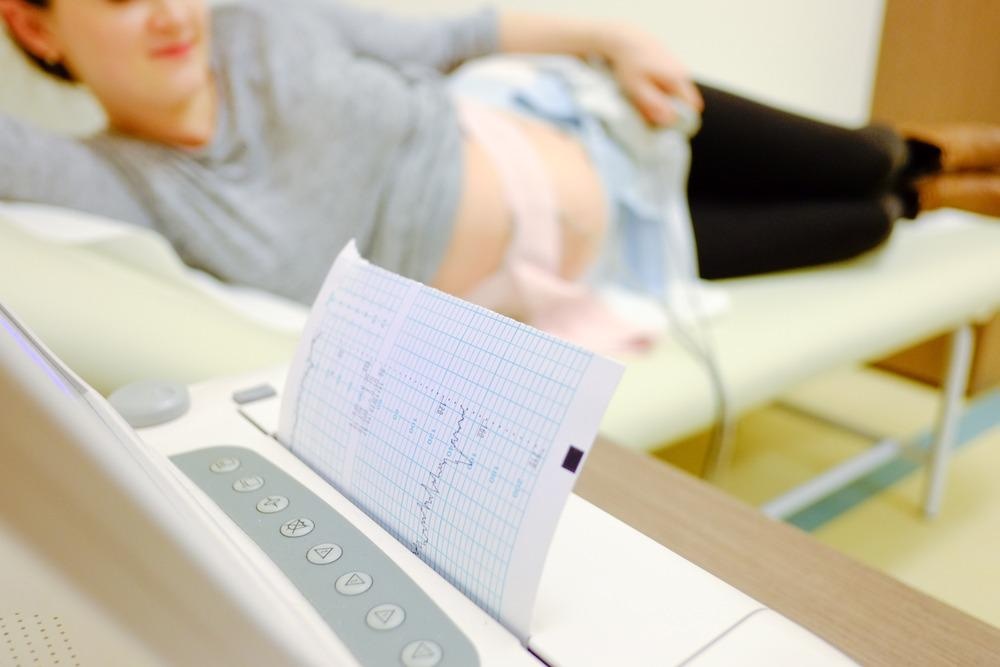One of the primary ways a clinician will monitor fetal health is by analyzing fetal heart rate (fHR) against the background of uterine activity and fetal movements. However, even when fHR is detected, there will usually be periods of signal loss, thus making this method insufficient for long-term monitoring of fetal health.

Image Credit: Soft Light/Shutterstock.com
Typically, fHR is measured with cardiotocography (CTG), which obtains measurements based on Doppler ultrasound. Unfortunately, the sensitivity of CTG measurements is dictated by the fetal position and movement; therefore, the healthcare provider will often have to reposition the transducer to obtain a satisfactory fHR result.
Advantages and Disadvantages of Electrocardiograms
Compared with methods based on ultrasound waves, devices that acquire electrophysical signals have also been used to overcome the limitations associated with CTG for fetal health monitoring. Through this approach, adhesive wet electrodes, which are typically silver (Ag) or silver chloride (AgCl), are applied to the surface of the maternal abdomen. One of the key advantages of this fetal electrocardiogram (fECG) approach is that fHR can be determined with high efficiency and accuracy, especially when compared to the signals obtained with CTG.
Despite the utility of this approach, the contact electrodes used during a fECG can be uncomfortable and cause adverse reactions, especially if they remain in contact with the mother’s abdomen for extended periods of time. In addition to being uncomfortable, prolonged use of these electrodes can also cause the gel to dehydrate, thus reducing the quality of the acquired signal.
Dry or capacitive sensing electrodes have been developed as a promising alternative to traditional wet electrodes for fECG acquisition. Some of the key advantages associated with these dry electrodes include easing device integration into wearable materials that can be worn for extended periods without causing skin irritation. However, the lack of gel between the skin and the electrode can reduce the signal amplitude and increase the chance of artifact signals.
Developing Dry, Textile Electrophysical Sensors
In a recent study published in the journal Sensors on June 23rd, 2021, researchers designed dry, textile electrophysiological sensors for fHR monitoring, employing an fHR estimation algorithm based and designed on signals acquired by the dry electrodes.
The prototype acquisition system included textile electrodes composed of conductive fabric connected to the prototype amplifier through 1.5 meter wires. The electrodes were then placed directly on the abdomen of the mother through the use of elastic belts.
To test their algorithm, two datasets consisting of semi-simulated (DS-SS) and real (DS-R) acquisitions were evaluated. The DS-SS dataset involved nonpregnant women used to obtain a reference value for maternal ECG (mECG) values. The fECG was then superimposed on the abdomen of the nonpregnant women to generate a reference value for the fECG. Comparatively, the DS-R group included pregnant women with a gestational age of at least 36 weeks with no known maternal or fetal complications.
Eliminating artifacts
A blind source separation (BSS) technique was used to isolate the mECG values from the FECG values in real-time. The elimination of mECG signals was obtained by Independent Component Analysis (ICA), applying an algorithm to separate the mECG signals into their main components.
Since fetal movement can cause artifacts in signal production, main processing steps were utilized to reduce their influence on the final estimation of the fHR. Several pre-processing strategies were also employed to remove triboelectricity, filtering, and amplitude demodulation artifacts.
Once all artifacts were successfully eliminated, fECG enhancement and fHR estimation could be achieved. It should be noted that the lack of gel between the skin and the electrodes increases contact impedance, thus increasing the difficulty associated with extracting the fHR values. An additional challenge that arose due to the lack of contact is that the electrodes are subject to both vertical and lateral movements that can alter the quality of the acquired signals.
The several pre-and main processing steps incorporated into this novel approach eliminated all possible artifacts despite these potential hurdles. The researchers successfully estimated fHR values from signals obtained from these dry electrodes comparable to those acquired with wet electrodes. The algorithm employed here successfully reached a sensitivity of 95% while also reducing the root-mean-square error (RMSE) to lower than five beats per minute (bpm).
Conclusion
The algorithm discussed here is unique in that it eliminates artifacts by considering their distinct sources and characteristics. In doing so, it is more effective and suitable for removing noise that would otherwise interfere with the production of accurate fECG measurements. Although future work will be needed to increase the robustness of this system, the current study found that their proposed approach to fHR monitoring is an accurate and reliable method for fHR estimation.
References and Further Reading
Matonia, A., et al. (2020) Fetal electrocardiograms, direct and abdominal with reference heartbeat annotations. Nature Scientific Data, 7(1). Available at: https://doi.org/10.1038/s41597-020-0538-z
Galli, A., et al. (2021) Dedicated Algorithm for Unobtrusive Fetal Heart Rate Monitoring Using Multiple Dry Electrodes. Sensors, 21(13), p.4298. Available at: https://doi.org/10.3390/s21134298
Yuan, L., Yuan, Y., Zhou, Z., Bai, Y. and Wu, S., (2019) A Fetal ECG Monitoring System Based on the Android Smartphone. Sensors, 19(3), p.446. Available at: https://doi.org/10.3390/s19030446
Disclaimer: The views expressed here are those of the author expressed in their private capacity and do not necessarily represent the views of AZoM.com Limited T/A AZoNetwork the owner and operator of this website. This disclaimer forms part of the Terms and conditions of use of this website.